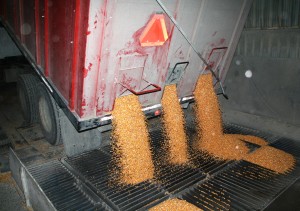The Thistle Ha’ corn harvest is done. Despite a late planting due to a very wet spring, the corn yield was quite good.
I accompanied a 20-tonne load of corn to the local mill, and talked to the general manager. He surprised me when he said that they sell most of their corn as ethanol feedstock. Although Canada started promoting use of biomass (corn, wood products) to manufacture ethanol fuel in 2000 to combat global warming, he said the shift of corn sales from food to fuel has occurred just recently, after the U.S. government started subsidizing corn as a biofuel. This resulted in construction of numerous ethanol plants using corn as feedstock.
40% of the 2010 corn crop in the U. S. was converted to ethanol. This is past the “tipping point”; the U. S. corn crop is now insufficient to meet food needs. The wet spring in the U. S. mid-west and drought conditions in southern hemisphere corn growing regions has resulted in reduction of world-wide corn production in 2011, pushing corn to its highest price in recent memory. This has led to increased prices for other food crops such as soybeans and cereal grains. Although this trend has been beneficial to grain farmers and big agribusiness, increased feed prices have hit the poultry and hog industries hard. Cattle farmers are less affected since the corn mash byproduct from ethanol production is sold for cattle feed. More worrisome, some economists claim that the price of corn has started to track the price of crude oil. Has the U. S. policy to increase corn ethanol production in an effort to reduce the cost of imported crude oil to the American economy not only failed to reduce the cost of energy, but actually caused a permanent increase in global food prices?

